
table of contents
Organic Acids test
Organic Acids test results in October 2015
Excerpt from record 2
the first page
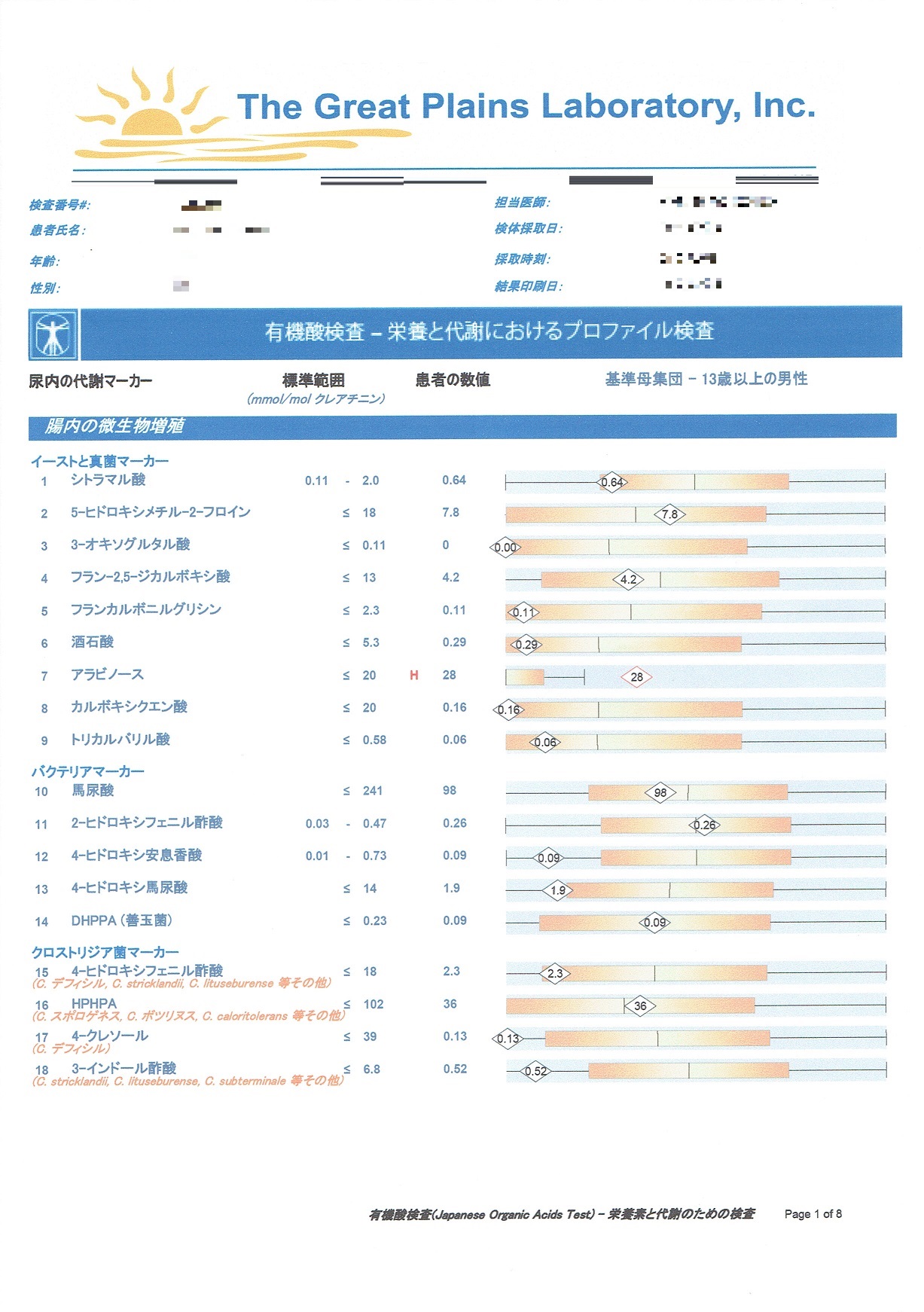
This is the first page of the Organic Acids test results.
Organic Acid Testing-Profile Testing in Nutrition and Metabolism
Growth of microorganisms in the intestine
Yeast and fungal markers
1 Citramalic acid
2 5-hydroxymethyl-2-furoic
3 3-oxoglutarate
4 Furan-2.5-dicarboxylic acid
5 Furancarbonylglycine
6 Tartaric acid
7 Arabinose
8 Carboxycitric acid
9 Tricarballylic acid
Bacterial marker
10 Hippuric acid
11 2-hydroxyphenylacetic acid
12 4-hydroxybenzoic acid
13 4-hydroxyhippuric acid
14 DHPPA (good bacteria) 3,4-dihydroxyphenylpropionic acid
Clostridia marker
15 4-hydroxyphenylacetic acid
16 HPHPA 3-(3-hydroxyphenyl)-3-hydroxypropanoic acid
17 4-cresol
18 3-indole acetic acid
2nd page
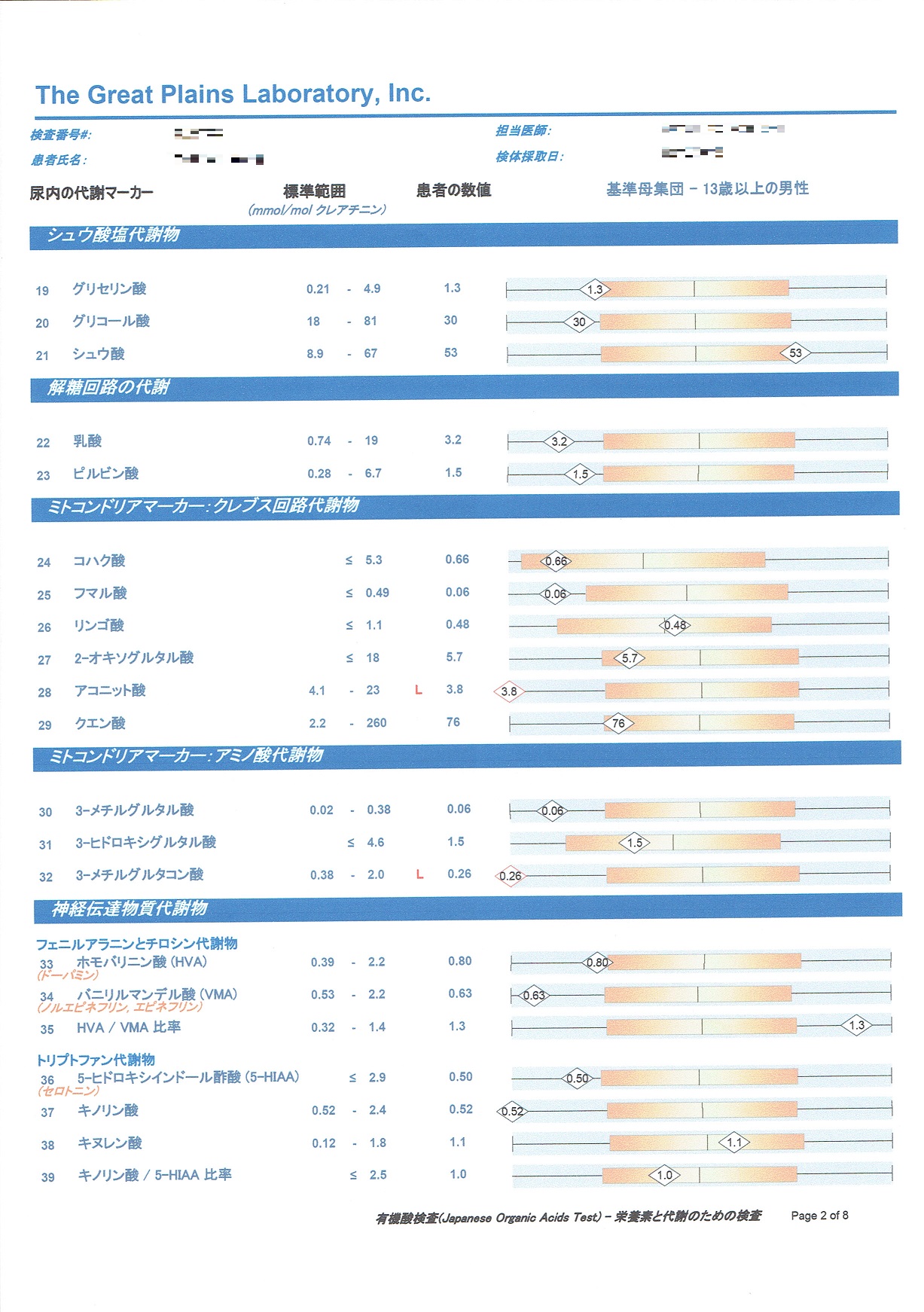
Oxalic acid metabolite
19 Glyceric acid
20 Glycolic acid
21 Oxalic acid
Glycolytic circuit metabolism
22 Lactic acid
23 Pyruvate
Mitochondrial marker: Krebs cycle metabolites
24 Succinic acid
25 Fumaric acid
26 Malic acid
27 2-oxoglutarate
28 Aconitic acid
29 citric acid
Mitochondrial markers: amino acid metabolites
30 3-methyl glutaric acid
31 3-hydroxyglutaric acid
32 3-methylglutaconic acid
Neurotransmitter metabolites
Phenylalanine and tyrosine metabolites
33 Homovanillic acid (HVA)
(Dopamine)
34 Vanillyl mandelic acid (VMA)
(Norepinephrine, epinephrine)
35 HVA / VMA ratio
Tryptophan metabolite
36 5-hydroxyindole acetic acid (5-HIAA)
(Serotonin)
37 Quinolinic acid
38 Kynurenic acid
39 Quinolinic acid / 5-HIAA ratio
3nd page
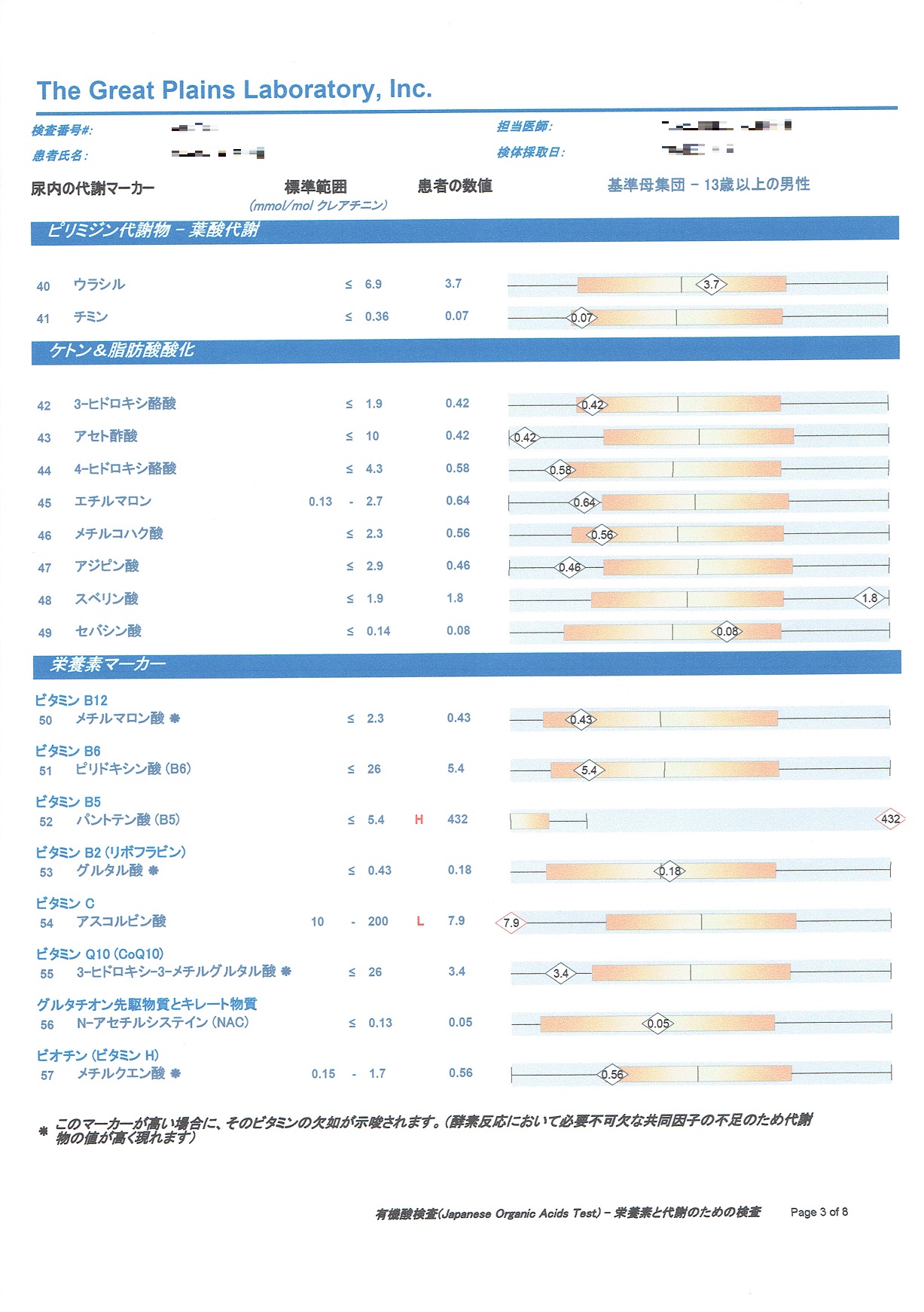
Pyrimidine metabolites-folate metabolism
40 Uracil
41 Thymine
Ketone & fatty acid oxidation
42 3-hydroxyacetic acid
43 Acetoacetic acid
44 4-hydroxyacetic acid
45 Ethyl malon
46 Methylsuccinic acid
47 Adipic acid
48 Suberic acid
49 Sebacic acid
Nutrition marker
Vitamin B12
50 Methyl malonic acid *
Vitamin B6
51 Pyridoxic acid (B6)
Vitamin B5
52 Pantothenic acid (B5)
Vitamin B2 (lipoflavin)
53 Glutaric acid *
Vitamin C
54 Ascorbic acid
Vitamin Q10 (CoQ10)
55 3-hydroxy-3-methyl glutaric acid *
Glutathione precursors and chelating substances
56 N-acetyl-L-cysteine (NAC)
Biotin (vitamin H)
57 Methyl citric acid *
* high value for this marker indicates a vitamin deficiency.(High levels of metabolites appear as there are no essential cofactors for enzymatic reactions)
4nd page
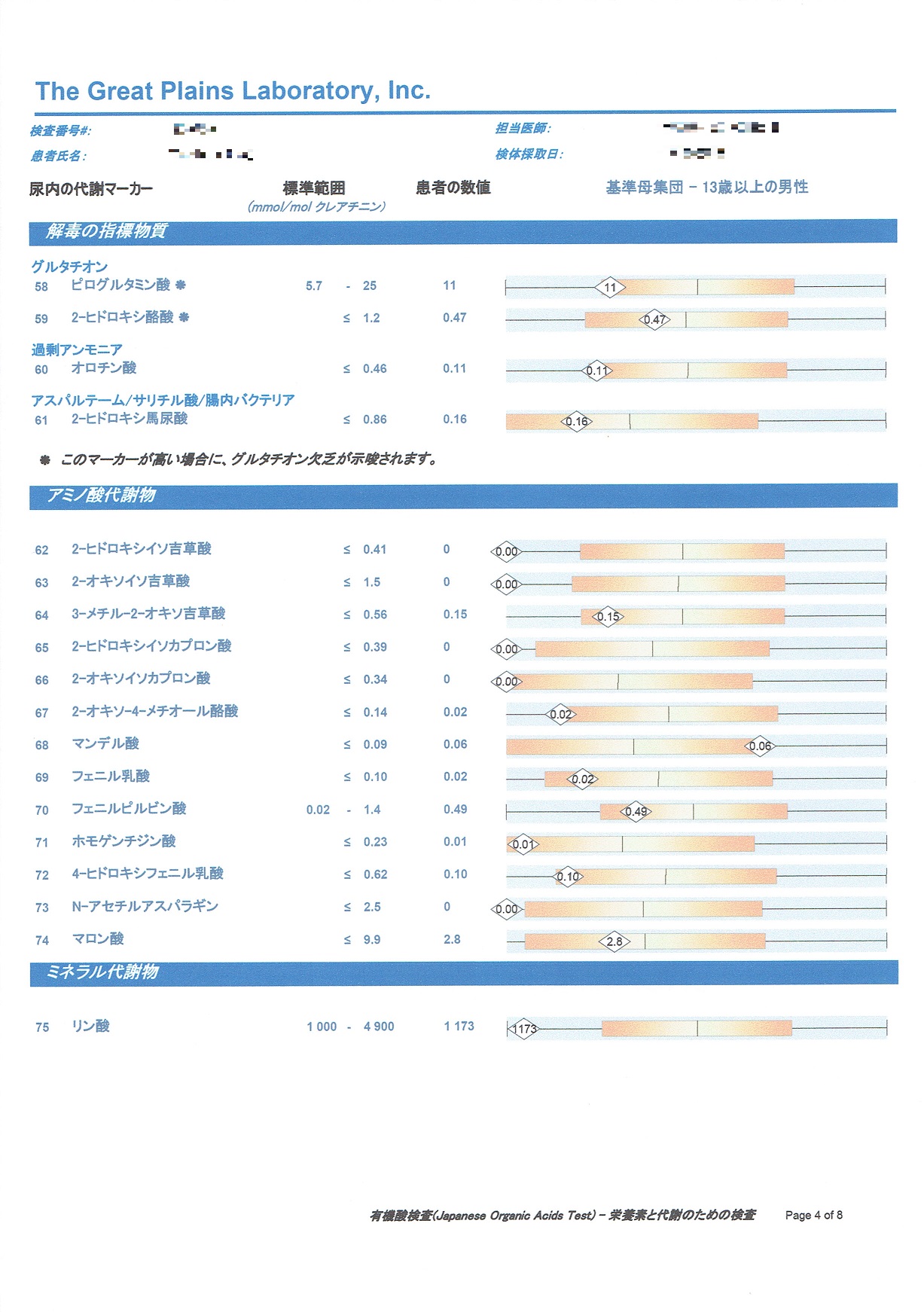
Substances that are indicators of detoxification
Glutathione
58 Pyroglutamic acid *
59 2-hydroxyacetic acid *
Excess ammonia
60 Orotic acid
Aspartame / salicylic acid / enteric bacteria
61 2-hydroxyhippuric acid
* High levels of this marker suggest glutathione deficiency.
Amino acid metabolites
62 2-hydroxyisovaleric acid
63 2-oxoisovaleric acid
64 3-methyl-2-oxovaleric acid
65 2-hydroxyisocaproic acid
66 2-oxoisocaproic acid
67 2-oxo-4-methylbutyric acid
68 Mandelic acid
69 Phenyl lactic acid
70 Phenylpyruvic acid
71 Homogentisic acid
72 4-hydroxyphenyl lactic acid
73 N-acetyl asparagine
74 Malonic acid
Mineral metabolites
75 phosphoric acid
5nd page (description)
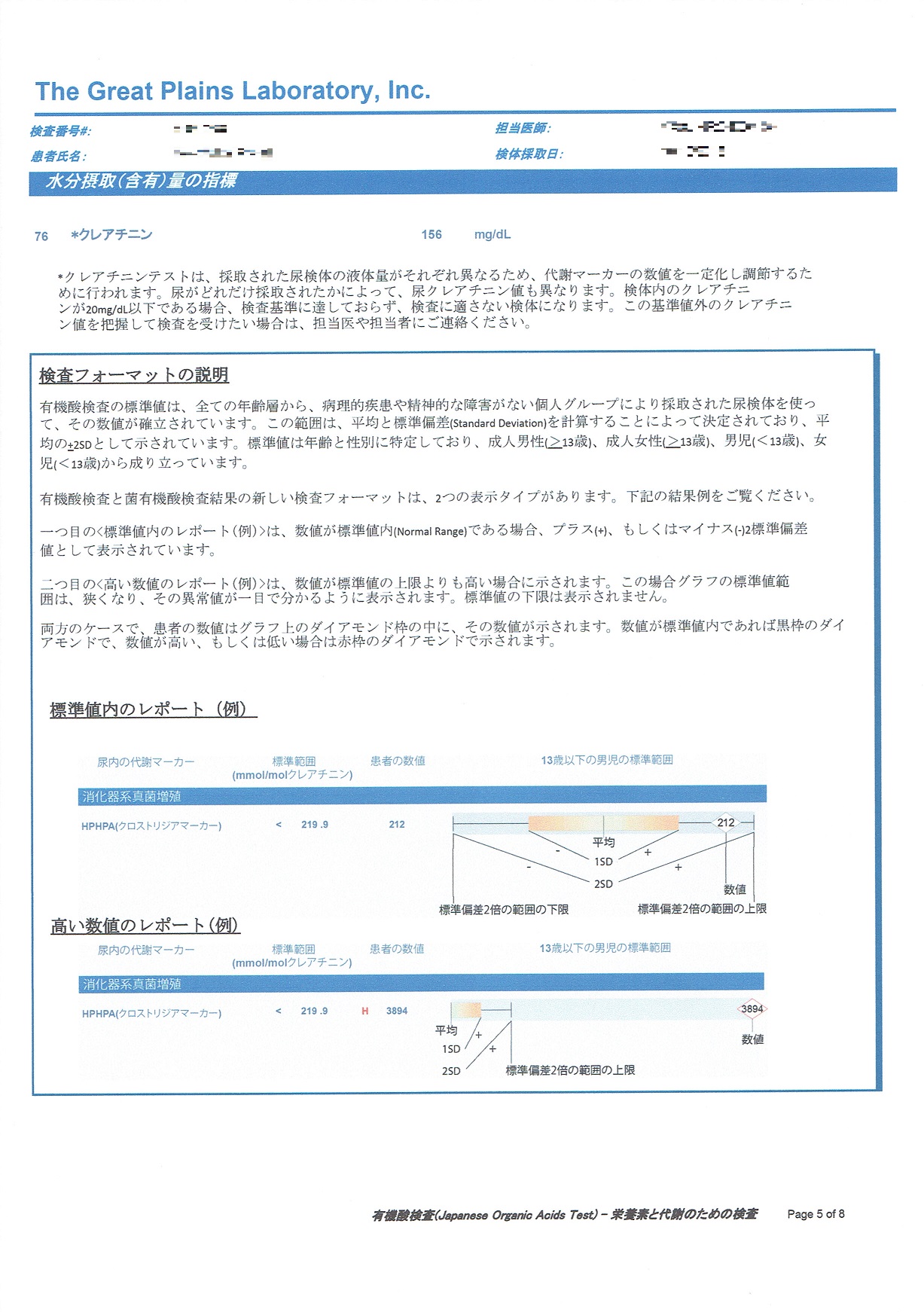
Index of water intake (content)
76 *Creatinine
*Since urine samples collected have different body fluid volumes, the creatinine test is used to stabilize and adjust the number of metabolic markers.
Urinary creatinine levels also vary depending on how much urine is collected.
If the amount of creatinine in the sample is less than 20 mg / dL, the sample does not meet the test criteria and is not suitable for testing.
If you want to test with a creatinine value other than this standard value, please consult your doctor or staff.
Inspection format description
Standard values for organic acid tests are established using urine samples taken by groups of individuals without morbidity or mental illness from all age groups.
This range is determined by calculating the mean and standard deviation and is displayed as ± 25D of the mean.
The standard values are specified by age and sex, and consist of adult males (≧ 13 years old), adult females (≧ 13 years old), boys (<13 years old), and girls (<13 years old).
The new test format for organic acid test and microbial organic acid test result has two display types.
See example results below.
In the first example, when the numerical value is within the standard value (Normal Range), it is displayed as plus (+) or minus (-) 2 standard deviation value.
The second example is displayed when the number exceeds the standard upper limit.
In this case, the reference value range of the graph is narrowed and the abnormal value is displayed so that it can be seen at a glance.
The lower limit of the standard value is not displayed.
In both cases, the patient number is shown in the diamond box on the graph.
If the numerical value is within the standard value, it will be displayed with a black framed diamond, and if the value is high or low, it will be displayed with a red framed diamond.
Report within the standard value (example)
Report outside standard value (example)
6nd page
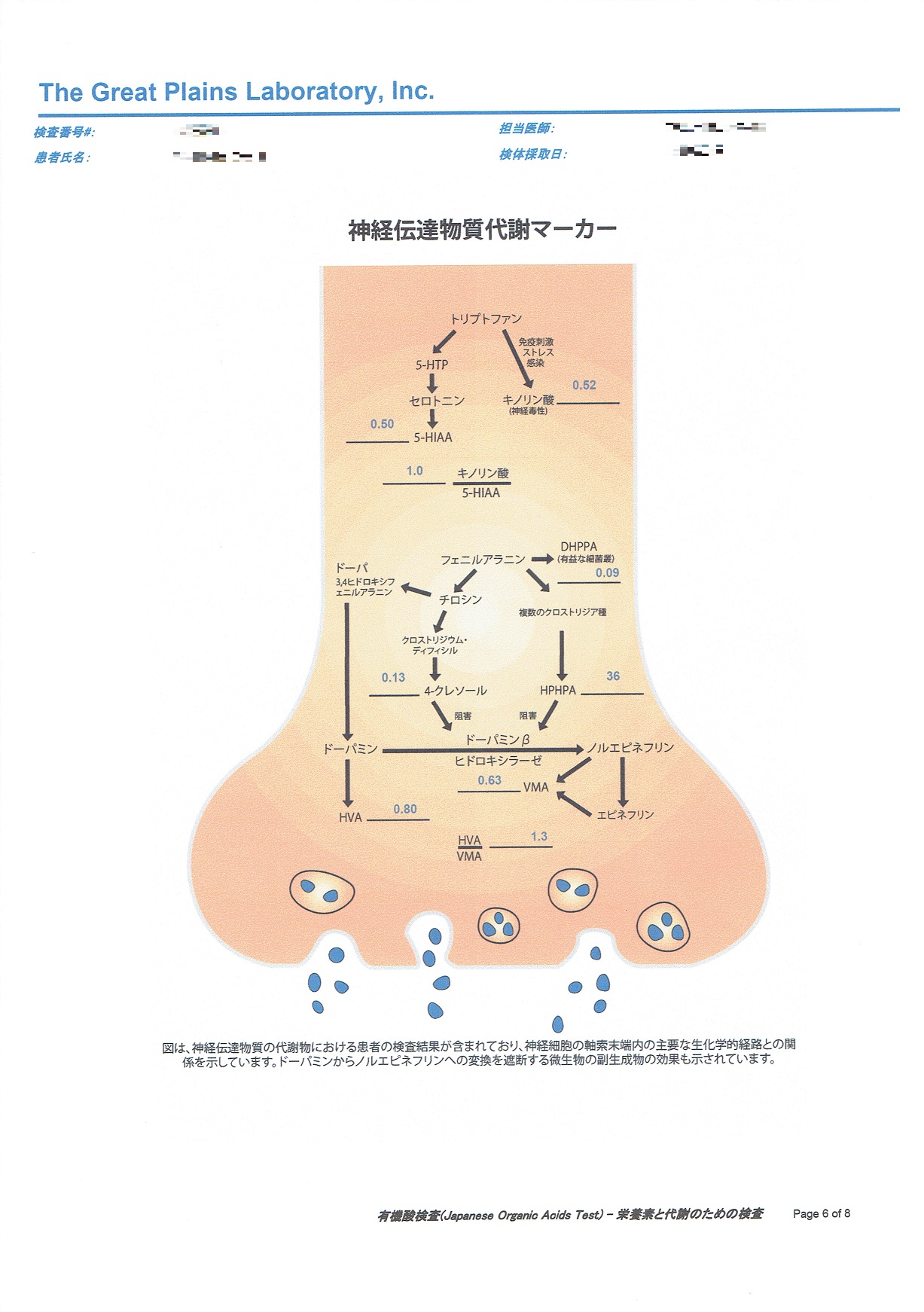
Neurotransmitter metabolism marker
The figure contains patient test results for neurotransmitter metabolites and shows their relationship to the major biochemical pathways within the axon terminals of neurons.
The effect of microbial byproducts that block the conversion of dopamine to norepinephrine has also been shown.
7nd page
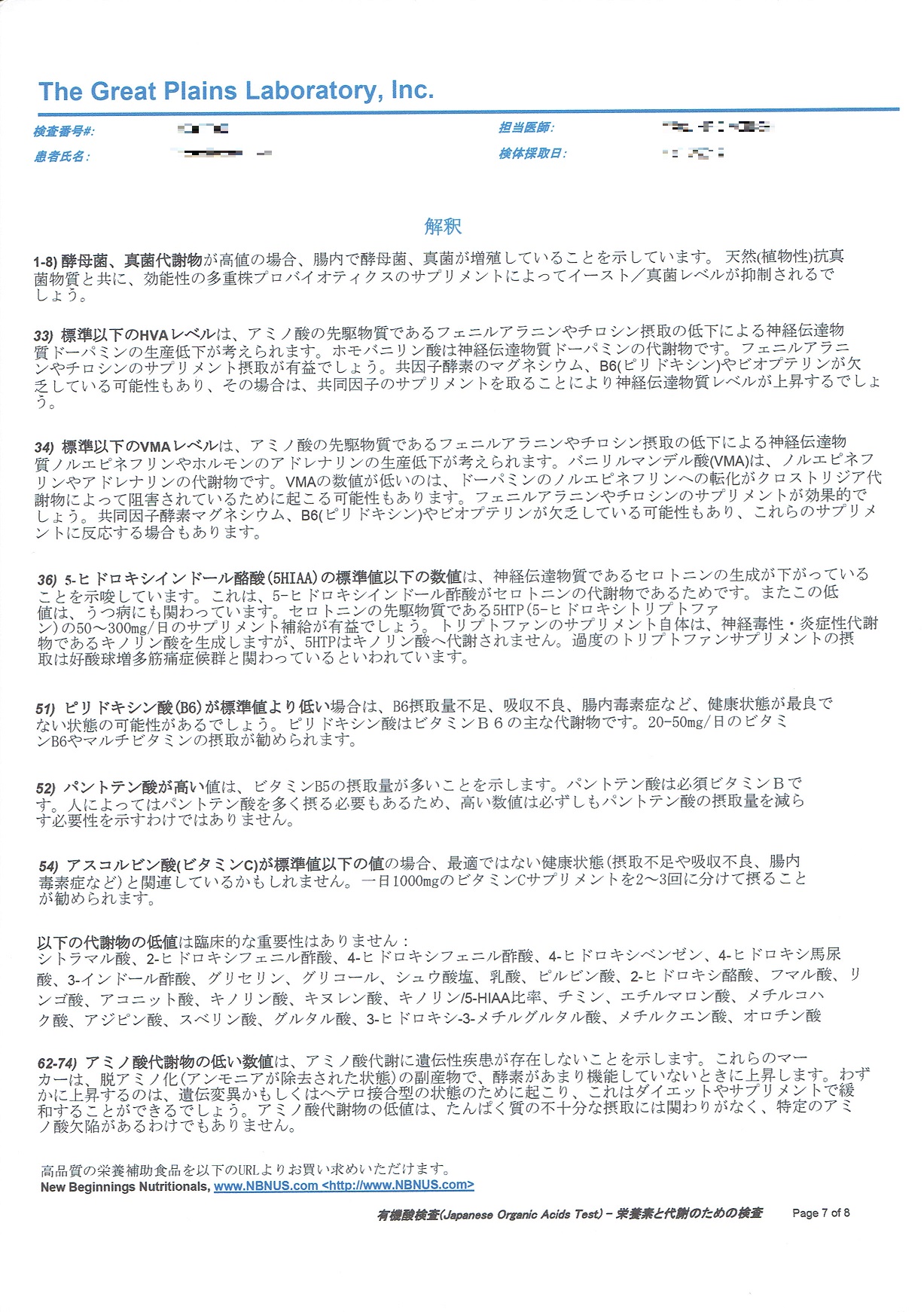
Interpretation
1-8) High levels of yeast and fungal metabolites indicate that yeast and fungi are growing in the intestine.
Yeast / fungal levels will be suppressed by potent multi-strain probiotic supplements along with natural (vegetable) antifungal substances.
33) Substandard HVA levels may be due to decreased production of the neurotransmitter dopamine due to decreased intake of the amino acid precursors phenylalanine and tyrosine.
Homovanillic acid is a metabolite of the neurotransmitter dopamine. Taking phenylalanine and tyrosine supplements may be beneficial.
It may also be deficient in the factor enzymes magnesium, B6 (pyridoxine), and biopterin, in which case taking supplements will increase neurotransmitter levels.
34) Substandard VMA levels may be due to decreased production of the neurotransmitter norepinephrine and the hormone adrenaline due to decreased intake of the amino acid precursors phenylalanine and tyrosine.
Vanillyl mandelic acid (VMA) is a metabolite of norepinephrine and adrenaline.
Low VMA levels may also be due to inhibition by the Clostridial metabolites during conversion to dopamine norebinephrine.
Phenylalanine and tyrosine supplements are effective.
They may be deficient in the cofactor enzymes magnesium, B6 (pyridoxine) and biopterin, and may respond to these supplements.
36) Values below the standard value for 5-hydroxyindoleacetic acid (5HIAA) suggest that the production of the neurotransmitter serotonin is down.
This is because 5-hydroxyindoleacetic acid is a metabolite of serotonin.
This low value is also associated with depression.
Supplementing 50-300 mg / day of 5HTP (5-hydroxytryptophan), a precursor of serotonin, may be beneficial.
Tryptophan supplement itself produces quinolinic acid, a neurotoxic and inflammatory metabolite, but 5HTP is not metabolized to quinolinic acid.
Excessive tryptophan supplementation is said to be associated with eosinophilia myalgia syndrome.
51) If pyridoxic acid (B6) is below the standard, you may not be in good health due to insufficient B6 intake, malabsorption, or enterotoxemia.
Pyridoxic acid is the main metabolite of vitamin B6.
20-50 mg / day of vitamin B6 and multivitamins are recommended.
52) High levels of pantothenic acid indicate a high intake of vitamin B5.
Pantothenic acid is an essential vitamin B.
Higher numbers do not necessarily indicate a need to reduce pantothenic acid intake, as some people may need to consume more pantothenic acid.
54) Substandard levels of ascorbic acid (vitamin C) may be associated with suboptimal health conditions (such as underdose, malabsorption and enterotoxemia).
It is recommended to take 1000mg of vitamin C supplement daily in 2 to 3 divided doses.
Low levels of the following metabolites are not clinically significant:
Citramalic acid, 2-hydroxyphenylacetic acid, 4-hydroxyphenylacetic acid, 4-hydroxybenzene, 4-hydroxyhippuric acid, 3-indoleacetic acid, glycerin,Glucose, oxalate, lactic acid, pyruvic acid, 2-hydroxybutyric acid, fumaric acid, malic acid, aconitic acid, quinolinic acid, kynurenic acid, quinoline / 5-HIAA ratio,Thymine, ethylmalonic acid, methylsuccinic acid, adipic acid, suberic acid, glutaric acid, 3-hydroxy-3-methylglutanic acid, methylcitric acid, orotic acid
62-74) Low numbers of amino acid metabolites indicate the absence of genetic disorders in amino acid metabolism.
These markers are byproducts of deamination (the state of ammonia removed) and are elevated when the enzyme is poorly functioning.
Slight increases may be due to genetic mutations or heterozygous conditions and may be alleviated with dietary restrictions and supplements.
Low levels of amino acid metabolites are not associated with inadequate protein uptake and are not specific amino acid defects.
8nd page
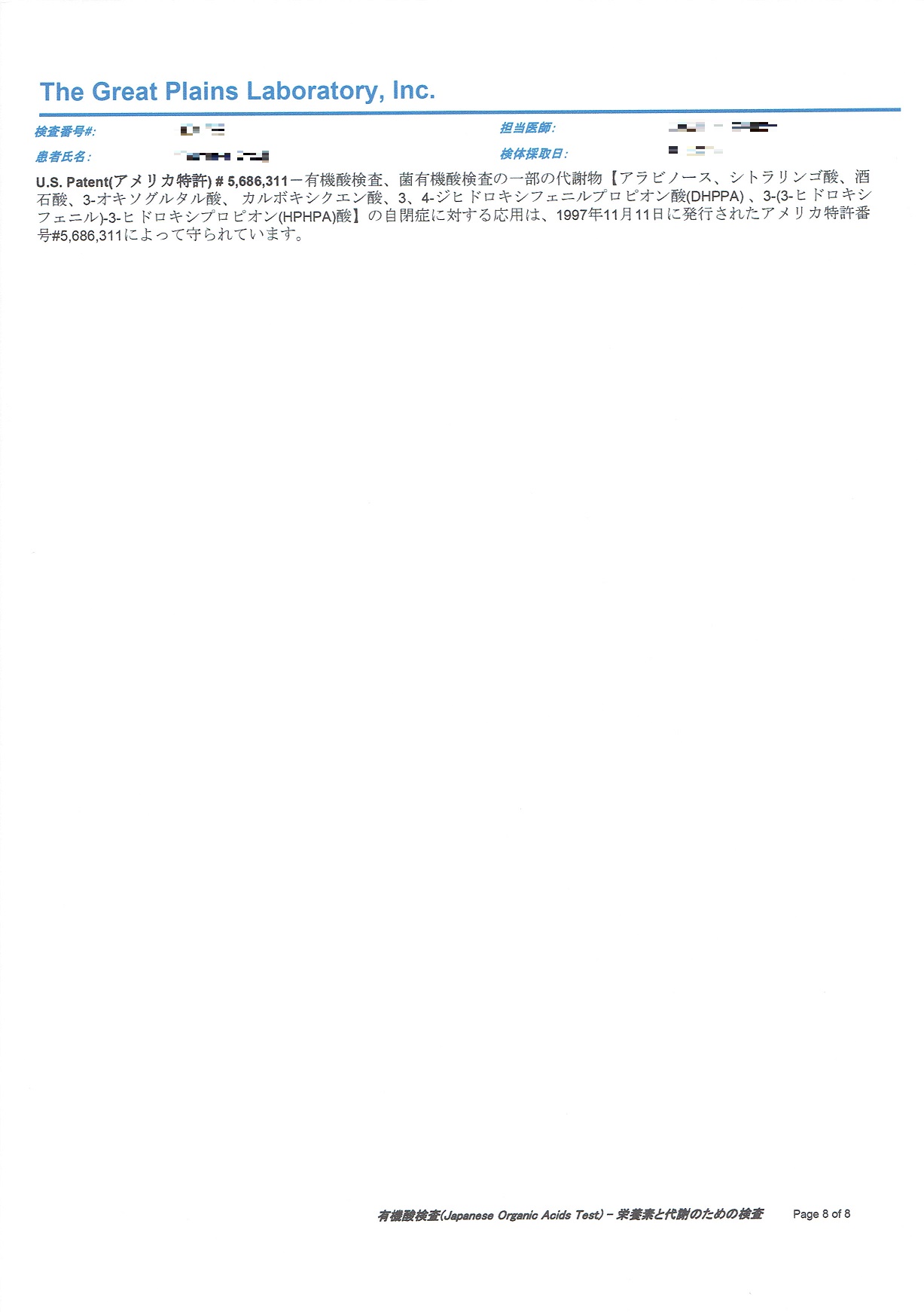
U.S. Patent (US Patent) # 5,686,311-organic acid test, some metabolites of fungal organic acid test [arabinose, citramalic acid, tartaric acid, 3-oxoglutaric acid,
Carboxycitric acid, 3,4-dihydroxyphenylpropionic acid (DHPPA), 3- (3-hydroxyphenyl) -3-hydroxypropionic acid (HPHPA)
Responses to autism are covered by US Patent # 5,686,311 issued November 11, 1997.